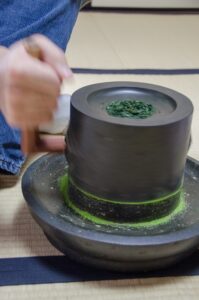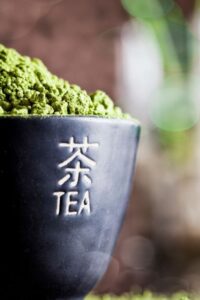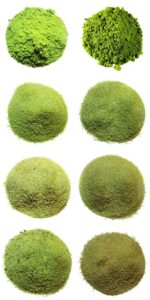
In the modern era, the significance of the traditional tool used for making matcha powder, the “Ishi-usu” (石臼), or stone mortar, often goes unnoticed. The Japanese stone mortar consists of two cylindrical stone pieces, one placed atop the other, featuring a handle for rotation. This essential tool can grind various foods, including rice, grains, and tea leaves. When using an Ishi-usu mortar to grind matcha, whether manually or electrically, it requires approximately one hour to produce only 40 grams of matcha powder, contributing to the higher cost of matcha compared to other tea leaves.
The Ishi-usu boasts a rich history of over 1,400 years. In earlier times, it was a common fixture in Japanese households, used for grinding rice into flour for udon noodles or for processing soybeans to make tofu. The grinding process involved placing the ingredients in the top compartment of the mortar, which was then turned back and forth, causing the two stones to rub against each other. This method required significant physical effort. Traditionally, during courtship, a groom would grind rice flour using the Ishi-usu, and the bride would use it to create manju (small Japanese steamed buns filled with red bean paste or chestnuts). This practice served as a means of bonding and understanding each other’s habits. However, few Japanese homes still possess this type of stone mortar, and those that do can be quite costly, with prices for small mortars ranging from 20,000 to 70,000 baht.
The art of stone grinding tea was introduced to Japan in the 12th century by the Zen Buddhist monk Eisai, who had observed the technique in China. While this grinding method did not gain popularity in China, it continued in Japan, becoming integral to the culture. Matcha powder was initially introduced as part of Zen Buddhist rituals and later became a favored beverage among the upper classes of feudal Japan. Today, the appreciation for matcha has expanded globally.
There is a saying: “Matcha must be powdered green tea, but not all powdered green tea is matcha.” This distinction is crucial because high-quality tea leaves, specifically Tencha leaves, are preferred for grinding into fine powder. However, the surge in matcha’s popularity has led to price reductions, resulting in some green tea powders on the market containing added ingredients like flour, which detracts from the authenticity of traditional Japanese matcha. A comparison of matcha powder from various brands often reveals differences in color and fineness, indicating the quality of the product.
The craftsmanship involved in grinding Tencha leaves using the Ishi-usu is also vital. Grinding must be performed slowly and systematically, as the mortar is typically made from granite, a softer stone that generates minimal friction and heat. Excessive speed can result in overheating, leading to oxidized and burnt tea leaves, which in turn produces coarse matcha powder unsuitable for whisking with a chasen (tea whisk).
Slow and consistent grinding yields a fine matcha powder with a sweet aroma and rich umami flavor. Unfortunately, some producers resort to using steel balls or high-powered blenders to crush tea leaves, compromising the integrity, quality, nutrients, and flavor of the matcha. To maintain the authenticity of this traditional craft, certain establishments focus on quality control during production. For example, the Tea Museum in Fukuoka, Japan, features an Ishi-usu machine where visitors can experience the grinding process firsthand.




